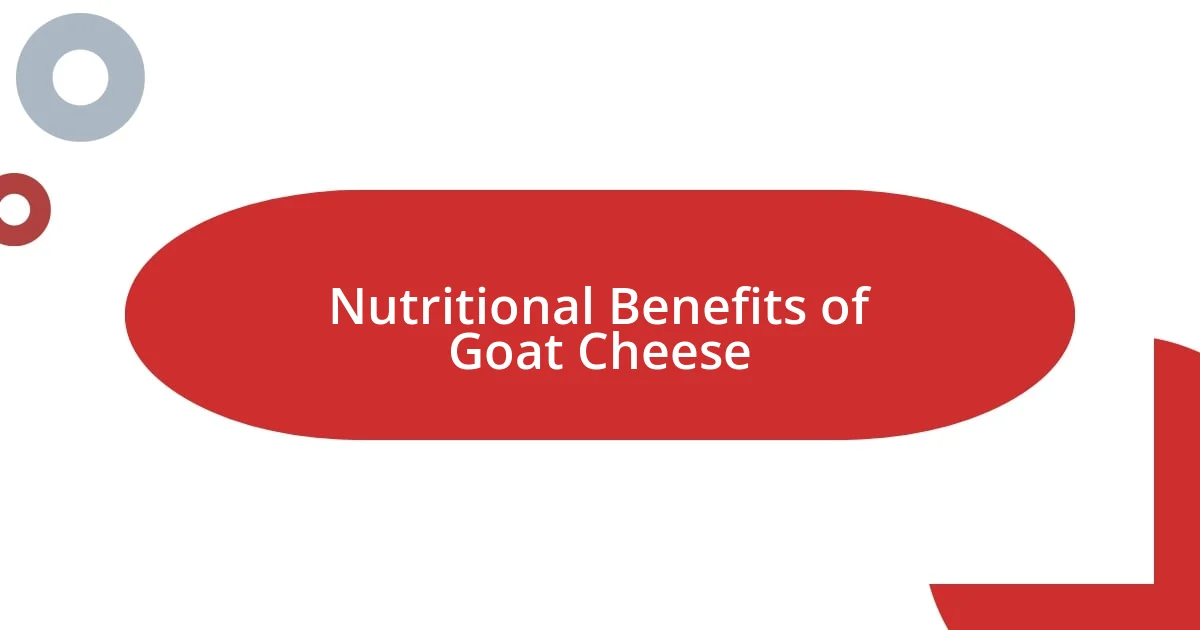Key takeaways:
- Goat cheese, or chèvre, is known for its unique tangy flavor and creamy texture, with various aging processes affecting its taste and digestibility.
- Nutritionally, goat cheese is rich in protein, calcium, vitamins, and lower in fat compared to cow’s milk cheese, making it beneficial for heart health and digestion.
- Pairing goat cheese with foods like roasted vegetables, fruit, and grains enhances dishes, while proper storage techniques, such as using parchment paper and olive oil, preserve its flavor and texture.

What is Goat Cheese
Goat cheese, also known as chèvre, is a delightful dairy product made from the milk of goats. What makes it stand out is its unique tangy flavor and creamy texture, which can range from soft and spreadable to firm and crumbly. I remember the first time I tried a fresh goat cheese log at a farmer’s market; the slight earthiness paired with a hint of sweetness intrigued my palate in a way that cow’s milk cheeses had not.
One fascinating aspect of goat cheese is its versatility in the kitchen. You can enjoy it on a charcuterie board, crumbled over salads, or even melted into pasta dishes. Have you ever thought about how the different aging processes affect its flavor? I was amazed to learn that younger cheeses tend to be milder and fresh, while aged varieties develop deeper, more complex flavors that are perfect for pairing with wines.
Another unique characteristic of goat cheese is its digestibility. Many people find it easier to digest than cow’s milk cheese due to its lower fat content and different protein structure. Personally, I’ve noticed that indulging in a goat cheese salad doesn’t leave me feeling heavy afterward; instead, it’s a light yet satisfying treat. It’s interesting to think about how this cheese not only pleases the palate but can also be a friendlier option for those with sensitive stomachs.

Nutritional Benefits of Goat Cheese
When it comes to nutritional benefits, goat cheese truly holds its own. I’ve found that incorporating it into my diet not only satisfies my taste buds but also provides valuable nutrients. It’s a fantastic source of protein, calcium, and vitamins, making it a great addition to a balanced diet. Interestingly, many find its lower cholesterol levels appealing, especially if they’re looking to maintain heart health.
Here are some key nutritional benefits of goat cheese:
- High in Protein: Great for building and repairing tissues.
- Good Source of Calcium: Important for bone health.
- Lower in Fat: Compared to cow’s milk cheese, making it easier to digest.
- Contains Prebiotics: Supports gut health and digestion.
- Rich in Vitamins: Especially vitamins A and K, which are essential for vision and bone health.
I remember swapping out my usual cheese for goat cheese in a recipe, and not only did it elevate the dish—it also left me feeling lighter and more energized afterward. It’s fascinating how these nutritional attributes can also enhance our overall well-being!

Unique Flavors of Goat Cheese
One of the things I find truly unique about goat cheese is its diverse flavor profile, which can vary significantly based on the region and production methods. For instance, I once tried a rosemary-infused goat cheese from a local farm, and the earthy notes combined with the creamy texture created an experience that was both unusual and delightful. The aromatic herbs transformed the cheese into something that felt gourmet, making it a perfect companion for crackers or a simple baguette.
Then there are the fruity varieties of goat cheese. Imagine sinking your teeth into a cheese that has hints of fig or apricot! I distinctly recall a tasting event where they served goat cheese with dried fruit; the balance of tanginess and sweetness was simply harmonious. It felt like your taste buds were going on a delightful journey, making cheese tasting a memorable, emotional experience.
Lastly, let’s not overlook the true artistry behind aged goat cheese. A visit to an artisan cheese shop left me in awe when I learned about how aging can lead to a robust, nutty flavor that completely transforms the cheese. One bite of a well-aged goat cheese paired with a rich red wine really gave me a new appreciation for this dairy delight. It’s amazing how time and attention to detail can amplify the natural characteristics, resulting in flavors that linger on your palate long after the last bite.
| Flavor Profile | Description |
|---|---|
| Fresh Goat Cheese | Mild, tangy, and creamy, often enjoyed spreadable. |
| Aged Goat Cheese | Nutty, complex, with a firmer texture and deeper flavors. |
| Herb-Infused Varieties | Flavors enhanced by herbs like rosemary or thyme, adding depth. |
| Fruit-Infused Varieties | Sweet notes from fruits like fig or apricot, balancing the tang. |

Popular Goat Cheese Varieties
There are several goat cheese varieties that stand out in the culinary world. When I first encountered fresh goat cheese, it was like a revelation! Its creamy, tangy quality made it an instant favorite for spreading on a warm baguette. I can still remember the delight that washed over me as I paired it with honey and fresh figs; the sweet and savory combination introduced my palate to an exciting new world of flavors.
On my cheese-tasting adventures, I fell head over heels for aged goat cheese, which boasts a more intense character. I had a memorable experience at a wine and cheese pairing event, where the nutty depth of an aged goat cheese completely transformed when combined with a robust red wine. Have you ever noticed how some flavors can whisper to you while others shout? That moment of realization left me pondering how aging can create such complexity in taste.
Herb-infused goat cheeses are another favorite of mine, especially when incorporating them into homemade dishes. The first time I used a thyme-infused variety in a creamy pasta recipe, I was astonished by how that herbal touch elevated the entire meal. Do you ever think about how a single ingredient can change the dynamic of a dish? That’s the magic of goat cheese! Its ability to enhance flavors truly makes it a versatile companion in many culinary adventures.

Pairing Goat Cheese with Foods
When it comes to pairing goat cheese with foods, one of my favorite combinations is fresh goat cheese with roasted vegetables. I recall a dinner party where I served a medley of roasted bell peppers and zucchini drizzled with balsamic glaze. Topping it off with crumbled fresh goat cheese sent the flavors soaring to new heights. The creaminess of the cheese beautifully complemented the caramelized sweetness of the veggies—an absolute crowd-pleaser and a warm, comforting experience.
Aged goat cheese lends itself remarkably well to fruit and nuts, creating an elegant cheese board. I often find myself slicing into a firm wedge of aged goat cheese, pairing it with slices of crisp apple and a handful of pecans. The nuttiness of the cheese combined with the crunch of the nuts and the tartness of the apple creates a delightful contrast that keeps me coming back for more. It’s that perfect sweet-and-savory balance that really resonates, and honestly, who doesn’t love a good charcuterie moment?
Finally, herb-infused goat cheese is a fantastic partner for grains. I once experimented with adding a garlic-herb goat cheese to a quinoa salad, and it was a revelation. The creamy texture melted into the fluffy grains, while the fresh herbs brought everything to life, creating an enticing burst of flavor in each bite. Have you ever thought about how herb-infused ingredients can really make a dish sing? That combination made me appreciate how a simple salad can become extraordinary with the right pairing!

Cooking with Goat Cheese
When it comes to cooking with goat cheese, my go-to dish has to be a warm goat cheese salad. I remember the first time I placed a muffin-sized round of goat cheese, crusted in breadcrumbs, in the oven. As it melted and brown edges formed, the delightful aroma filled my kitchen. Drizzled with a tangy vinaigrette and tossed with fresh arugula, it transformed a simple salad into a comforting masterpiece. Ever noticed how a warm, indulgent component can elevate even the most basic of salads?
I often play with flavors, mixing goat cheese into savory dishes. Recently, I whipped up a creamy goat cheese spread for a gathering. It started with just a base of softened cheese, but then I added roasted garlic and a hint of lemon zest. The moment my guests took a bite, eyes lit up. Have you experienced that joy of sharing a dish that excites people? It’s a thrilling reminder of how cooking can connect us all through food.
For those culinary explorations, pasta lovers might delight in goat cheese sauces that blend seamlessly into dishes. I once added crumbled goat cheese to a vibrant arrabbiata sauce. The result was a symphony of flavors that danced across my palate—spicy, creamy, and utterly delicious! The unique tang of the cheese cut through the spicy heat, creating a taste experience that lingered, inviting me to take just one more bite. Isn’t it amazing how a small twist can turn a familiar recipe into something truly memorable?

Tips for Storing Goat Cheese
Storing goat cheese properly can make a significant difference in both flavor and texture. I’ve learned that wrapping goat cheese in parchment paper and then placing it in an airtight container allows it to breathe while preventing it from drying out. This simple step enhances the cheese’s creaminess and keeps it fresh for longer, which I find particularly valuable when I want to savor that unique tangy flavor over a few days.
When it comes to preserving leftover cheese, I usually dip it in olive oil before storing it. This not only adds a rich layer of flavor but also creates a barrier against air, preventing spoilage. Have you ever tried this method? I can personally vouch for its effectiveness—my last batch of marinated goat cheese lasted well over a week, and each bite was just as delicious as the first, infused with herbs and garlic.
If you find yourself with a larger quantity of goat cheese, freezing it might be a wise choice. I remember freezing a batch of crumbled goat cheese for a pasta dish I planned to make later. Just a short thaw time and a gentle reintroducing to room temperature, and it was ready to elevate that meal to both creamy and tangy perfection. It’s fascinating how such a versatile ingredient, when stored right, can serve its purpose across several meals!















